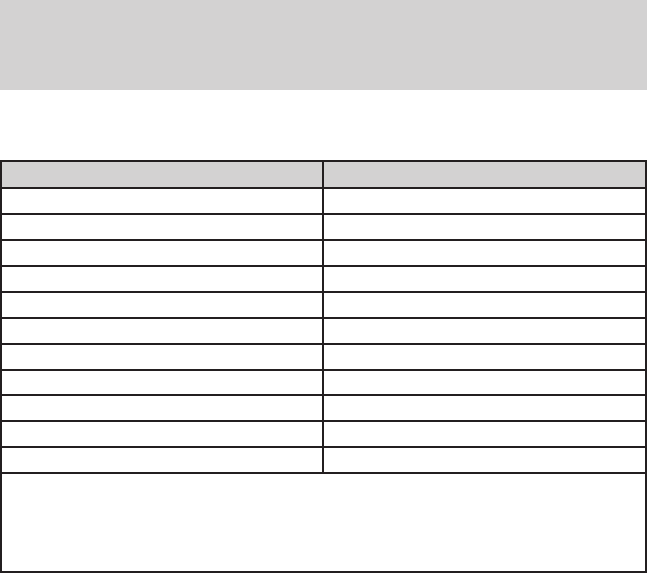Owner's Manual
Table Of Contents
- Table of Contents
- Introduction
- Instrument Cluster
- Entertainment Systems
- Climate Controls
- Lights
- Driver Controls
- MULTI-FUNCTION LEVER
- TILT STEERING WHEEL
- ILLUMINATED VISOR MIRROR (IF EQUIPPED)
- OVERHEAD CONSOLE (IF EQUIPPED)
- CENTER CONSOLE
- AUXILIARY POWER POINT (12VDC)
- POWER WINDOWS
- AUTOMATIC DIMMING REAR VIEW MIRROR (IF EQUIPPED)
- EXTERIOR MIRRORS
- SPEED CONTROL
- MOON ROOF (IF EQUIPPED)
- MESSAGE CENTER (IF EQUIPPED)
- LIFTGATE
- CARGO SHADE (IF EQUIPPED)
- LUGGAGE RACK (IF EQUIPPED)
- Locks and Security
- Seating and Safety Restraints
- FRONT SEATS
- REAR SEATS
- SAFETY RESTRAINTS
- Personal Safety System
- How does the Personal Safety System work?
- Driver and passenger dual-stage airbag supplemental restraints
- Front crash severity sensor
- Driver’s seat position sensor
- Front passenger sensing system
- Front safety belt usage sensors
- Front safety belt pretensioners
- Front safety belt energy management retractors
- Determining if the Personal Safety System is operational
- Safety restraints precautions
- Combination lap and shoulder belts
- Energy Management Feature
- Vehicle sensitive mode
- Automatic locking mode
- Safety belt height adjustment
- Safety belt pretensioner
- Safety belt extension assembly
- Safety belt maintenance
- Safety belt warning light and indicator chime
- BeltMinder
- Personal Safety System
- AIRBAG SUPPLEMENTAL RESTRAINT SYSTEM (SRS)
- Important SRS precautions
- Children and airbags
- How does the airbag supplemental restraint system work?
- Front passenger sensing system
- Determining if the system is operational
- Seat-mounted side airbag system (if equipped)
- Safety Canopy system (if equipped)
- Disposal of airbags and airbag equipped vehicles (including pretensioners)
- SAFETY RESTRAINTS FOR CHILDREN
- SAFETY SEATS FOR CHILDREN
- Tires, Wheels and Loading
- NOTICE TO UTILITY VEHICLE AND TRUCK OWNERS
- VEHICLE CHARACTERISTICS
- INFORMATION ABOUT UNIFORM TIRE QUALITY GRADING
- TIRES
- INFLATING YOUR TIRES
- TIRE CARE
- INFORMATION CONTAINED ON THE TIRE SIDEWALL
- TIRE PRESSURE MONITORING SYSTEM (TPMS)
- SNOW TIRES AND CHAINS
- VEHICLE LOADING – WITH AND WITHOUT A TRAILER
- TRAILER TOWING
- RECREATIONAL TOWING
- Driving
- STARTING
- ENGINE BLOCK HEATER (IF EQUIPPED)
- BRAKES
- STEERING
- PREPARING TO DRIVE
- AUTOMATIC TRANSMISSION OPERATION
- REVERSE SENSING SYSTEM (IF EQUIPPED)
- FOUR WHEEL DRIVE (4WD) SYSTEM (IF EQUIPPED)
- DRIVING THROUGH WATER
- Roadside Emergencies
- Customer Assistance
- GETTING THE SERVICES YOU NEED
- IN CALIFORNIA (U.S. ONLY)
- THE BETTER BUSINESS BUREAU (BBB) AUTO LINE PROGRAM (U.S. ONLY)
- UTILIZING THE MEDIATION/ARBITRATION PROGRAM (CANADA ONLY)
- FORD EXTENDED SERVICE PLAN
- GETTING ASSISTANCE OUTSIDE THE U.S. AND CANADA
- ORDERING ADDITIONAL OWNER’S LITERATURE
- REPORTING SAFETY DEFECTS (U.S. ONLY)
- REPORTING SAFETY DEFECTS (CANADA ONLY)
- Cleaning
- Maintenance and Specifications
- SERVICE RECOMMENDATIONS
- PRECAUTIONS WHEN SERVICING YOUR VEHICLE
- OPENING THE HOOD
- IDENTIFYING COMPONENTS IN THE ENGINE COMPARTMENT
- WINDSHIELD WASHER FLUID
- CHANGING THE WIPER BLADES
- ENGINE OIL
- BATTERY
- ENGINE COOLANT
- FUEL FILTER
- WHAT YOU SHOULD KNOW ABOUT AUTOMOTIVE FUELS
- ESSENTIALS OF GOOD FUEL ECONOMY
- EMISSION CONTROL SYSTEM
- POWER STEERING FLUID
- BRAKE FLUID
- TRANSMISSION FLUID
- AIR FILTER
- MOTORCRAFT PART NUMBERS
- MAINTENANCE PRODUCT SPECIFICATIONS AND CAPACITIES
- ENGINE DATA
- IDENTIFYING YOUR VEHICLE
- TRANSMISSION/TRANSAXLE CODE DESIGNATIONS
- Accessories
- Index

Note: You may not find this information on all tires because it is not
required by federal law.
Letter rating Speed rating - mph (km/h)
M 81 mph (130 km/h)
N 87 mph (140 km/h)
Q 99 mph (159 km/h)
R 106 mph (171 km/h)
S 112 mph (180 km/h)
T 118 mph (190 km/h)
U 124 mph (200 km/h)
H 130 mph (210 km/h)
V 149 mph (240 km/h)
W 168 mph (270 km/h)
Y 186 mph (299 km/h)
Note: For tires with a maximum speed capability over 149 mph
(240 km/h), tire manufacturers sometimes use the letters ZR. For
those with a maximum speed capability over 186 mph (299 km/h), tire
manufacturers always use the letters ZR.
8. U.S. DOT Tire Identification Number (TIN): This begins with the
letters “DOT” and indicates that the tire meets all federal standards. The
next two numbers or letters are the plant code designating where it was
manufactured, the next two are the tire size code and the last four
numbers represent the week and year the tire was built. For example,
the numbers 317 mean the 31st week of 1997. After 2000 the numbers
go to four digits. For example, 2501 means the 25th week of 2001. The
numbers in between are identification codes used for traceability. This
information is used to contact customers if a tire defect requires a recall.
9. M+S or M/S: Mud and Snow, or
AT: All Terrain, or
AS: All Season.
10. Tire Ply Composition and Material Used: Indicates the number of
plies or the number of layers of rubber-coated fabric in the tire tread and
sidewall. Tire manufacturers also must indicate the ply materials in the
tire and the sidewall, which include steel, nylon, polyester, and others.
2007 Mariner (mrn)
Owners Guide (post-2002-fmt)
USA (fus)
Tires, Wheels and Loading
145










